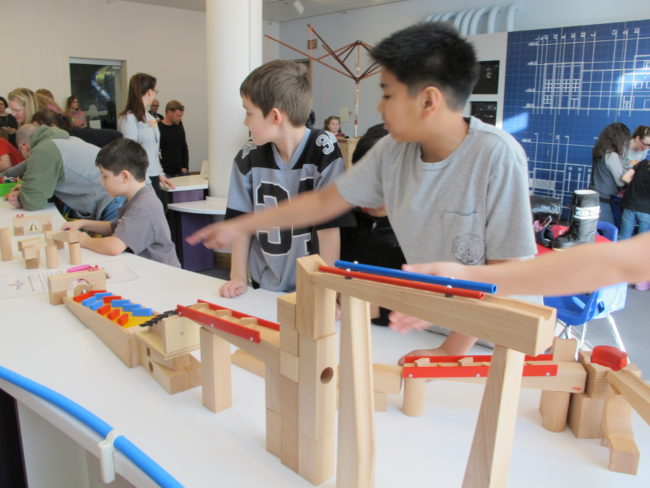
What do buckets, disco balls, circuits, and marbles have in common? They’re all part of the Anchorage Museum’s attempt to spark innovation in their new interactive exhibit.
Four-year-old Anabel Lantzman wanders into the Anchorage Museum’s new Spark!Lab ahead of the other kids and sees balls and pipes hanging from metal rods. Buckets and a bingo ball cage stick out from the base. It’s like a tree of stuff.
A volunteer hands her a drum stick and Anabel tentatively taps the different objects. The bucket sounds like a drum and the pipes ring like bells.
“So, are you allowed to hit things at home?” I inquire.
“No.”
“How does it feel to hit things here?”
“Good.”
She giggles and wanders to the next station — creating a mini hydroponic garden with nylon, pebbles, and cotton. Soon a group of fourth graders joins her and the room erupts in noise as they call to each other and bang loudly on all of the objects, seemingly at once.
So why encourage such chaos?
“This is not just banging things that’s going on here,” says Arthur Molella, the director of the Lemelson Center at the Smithsonian, which created the Spark!Lab. “This is all done with a purpose. Cause some of the same energies that are happening here — essentially this curiosity, a disciplined curiosity begins here and carries on through the rest of your life.”
Molella says that curiosity and creativity lead to innovation and invention. That’s why his center worked with educators to create the Spark!Lab. They’re helping museums around the United States set up their own localized versions. The Anchorage version, the sixth in the country, will soon include activities focused on the innovation required to live in the Arctic.
The students quickly disperse to the different activities around the room. Some design shoes, others use blocks, ramps, and mini xylophones to create an obstacle course for a marble.
Fourth grader Sandia Whalen is part of a group that’s trying to get a marble to go down a path, turn a corner and return to its start.
“But I don’t think sometimes it will work because there are things that are down at first but then go up but the marble can’t move up without being pushed,” Sandia explains.
“Because it’s not moving fast enough?”
“If it’s going fast enough then that might do it, but we have to make it go fast enough.”
Sandia is doing exactly what the exhibit designers intended — she’s problem-solving and innovating. Further down the table her classmate Matthew Hudson snaps together plastic pieces with wires embedded in them and connects them to batteries and propellers.
“It’s a circuit that’s really cool. Once you do it, this will spin around and go into the air,” he says, pointing at the propeller. “And it’s really cool.”
He says now that he knows the basics, he’s ready to design his own. “My own circuit, it would be like a train. It would be like tracks. It would move the train and bring me ice cream whenever I wanted ice cream.”
The Spark!Lab will be around for at least two years but the space will permanently be dedicated to creativity and invention. The exhibit is aimed mostly at children aged 6 to 12, though it includes a toddler area, too. It opens to the public Friday, March 6.
